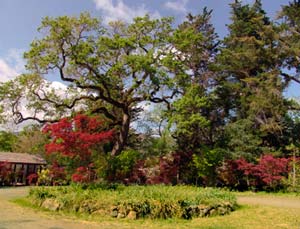 Frequently Asked Questions
Frequently Asked Questions
Do all Japanese maples need to grow in the shade?
How often should I water my Japanese maple?
Should I fertilize my new Japanese maple to get it off to a good start?
When is the best time to plant Japanese maples?
Do all Japanese maples lose their leaves?
What is a dwarf Japanese maple?
What is the most common cause of failure in growing Japanese maples?
Do all Japanese maples need to grow in the shade?
No! Many Acer palmatum cultivars are very happy in a sunny exposure. This includes the red dissectums (or lace leaf maples), as well as trees with wider, palmate lobes. In fact, the red leaved trees need a few hours of sunlight to maintain their red color. In the Sculpture Gardens at Wildwood, one sees many maples growing in full sun. Summer temperatures exceed 100 degrees.
We have found that Japanese maples with green lace leaves prefer partial shade during the afternoon. Cultivars of Acer shirasawanum and Acer japonicum also appreciate filtered sun.
Note: A young tree planted out in full sun will struggle and may not survive. If you wish to start the tree out in full sun, we recommend selecting a specimen that is at least 6 or 7 years old.
How often should I water my Japanese maple?
Roots of these trees need to remain evenly moist; and roots are not deep. Establish a regular watering routine. The frequency of watering depends on the temperature and how well your soil holds moisture. Of course mulching is very helpful. It can keep roots a bit warmer in winter and much cooler in the summer. During the summer it is preferable that leaves be dry by the time the sun reaches them.
Should I fertilize my new Japanese maple to get it off to a good start?
No. Thorough watering is the biggest help you can give your newly planted maple tree. Furthermore, maples are NOT heavy feeds. If the tree is planted in the landscape, it will not need fertilizer every year. Container grown trees benefit from one or two mild applications of fertilizer in the spring when all risk of frost is over.
When is the best time to plant Japanese maples?
Anytime! As long as you can be sure the tree will be properly watered, you may plant a container-grown maple tree (all our trees are container grown) any month of the year.
Do all Japanese maples lose their leaves?
Yes! Japanese maples are deciduous trees. During October and November maples provide a lovely show of fall color. Then in late November, or December, the leaves drop. Buds start to swell in February and March brings fresh new leaves—in colors that some say rival the show in autumn.
What is a dwarf Japanese maple?
In the winter, branches of maples are clearly visible without the distraction (albeit a lovely one) of leaves. Branching structure largely defines the category `dwarf' maple.
At Wildwood Nursery we grow 60-70 maples (cultivars of Acer palmatum or Acer p.) that remain compact and small. In 12 years, some will only grow to about 4 ft. (e.g. Acer p. Corallinum, Tama hime, or Yuri hime ). Others, like Koto no ito, Olsen's Frosted Strawberry or Shidava Gold, reach 8-9 ft. in 12 years.
There is some confusion among gardeners and garden enthusiasts when we use the term `dwarf.' By way of comparison let's look at maples in the `dissectum' category. Although they are not actually dwarf trees, their branches arch out and down. See the image of Acer p. Orangeola with its branches beginning to weep. Their structure is often likened to an umbrella; and they grow wider than tall.
What is the most common cause of failure in growing Japanese maples?
Poor drainage. In questioning customers whose maple trees have not leafed out in the spring, we find that the soil around the roots was very wet and soggy. Plant your tree in soil that is well aerated and you will find these trees easy to grow.
